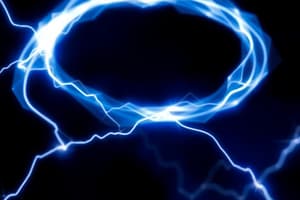Podcast
Questions and Answers
What happens when two like charges interact with each other?
What happens when two like charges interact with each other?
- They remain stationary
- They repel each other (correct)
- They merge into one charge
- They attract each other
What is the relationship between the repulsive force and the product of the magnitudes of the charges?
What is the relationship between the repulsive force and the product of the magnitudes of the charges?
- It is inversely proportional
- It is directly proportional (correct)
- It is unaffected
- It is exponentially proportional
What is the direction of the repulsive force between like charges?
What is the direction of the repulsive force between like charges?
- In a random direction
- Along the line joining the charges (correct)
- At an angle to the line joining the charges
- Perpendicular to the line joining the charges
What happens to the repulsive force between like charges as the distance between them increases?
What happens to the repulsive force between like charges as the distance between them increases?
What is the result of the repulsive force between like charges on their motion?
What is the result of the repulsive force between like charges on their motion?
What is the significance of the repulsion between like charges in natural phenomena?
What is the significance of the repulsion between like charges in natural phenomena?
Flashcards are hidden until you start studying
Study Notes
Like Charges Repel
- Like charges (charges of the same sign, either both positive or both negative) repel each other.
- This means that two positive charges or two negative charges will exert a repulsive force on each other.
Characteristics of Repulsion:
- The repulsive force between like charges is proportional to the product of the magnitudes of the charges.
- The repulsive force between like charges is inversely proportional to the square of the distance between the charges.
- Like charges repel each other with a force that is always directed along the line joining the charges.
Examples:
- Two positive charges, +q and +Q, will repel each other.
- Two negative charges, -q and -Q, will repel each other.
- The repulsive force between like charges can cause them to move away from each other.
Importance of Repulsion:
- The repulsion between like charges plays a crucial role in many natural phenomena, such as:
- The structure of atoms and molecules
- The behavior of electric currents
- The formation of electric fields
Like Charges Repel
- Like charges, either both positive or both negative, exert a repulsive force on each other.
Characteristics of Repulsion
- Repulsive force between like charges is proportional to the product of the magnitudes of the charges.
- Repulsive force between like charges is inversely proportional to the square of the distance between the charges.
- Force of repulsion between like charges is always directed along the line joining the charges.
Examples of Repulsion
- Two positive charges (+q and +Q) repel each other.
- Two negative charges (-q and -Q) repel each other.
- Repulsive force between like charges causes them to move away from each other.
Importance of Repulsion
- Repulsion between like charges plays a crucial role in:
- Atomic and molecular structure
- Electric current behavior
- Electric field formation
Studying That Suits You
Use AI to generate personalized quizzes and flashcards to suit your learning preferences.




